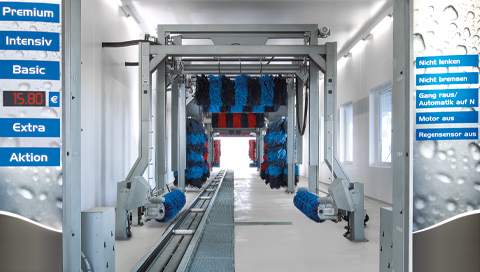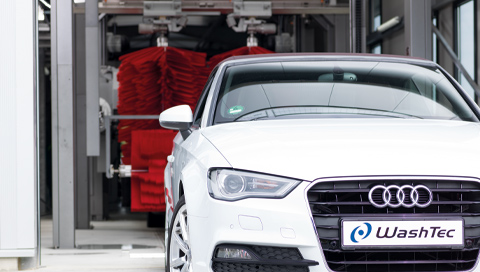
WashTec Cleaning Technology GmbH
Argonstraße 7
86153 Augsburg
Telephone +49 821 5584 0
Many owners of an automatic vehicle ask themselves the following question: How do I drive into the car wash with an automatic? In this article, you will get all the important information on this topic and learn
When entering a car wash, there is usually the following notice for vehicles with automatic transmission: "Select neutral, automatic selector lever to 'N", switch off the engine, do not steer, do not brake. "
However, these instructions no longer apply to many automatic vehicles of the newer generation. This is due to the automatic parking brake, which is fitted in many new vehicles. This works differently than the traditional handbrake, because it is activated as soon as the engine is switched off. In a conveyor tunnel car wash, this can cause the brake to lock the tires and the car to jump out of the automatic conveyor system.
The consequences result in expensive damage to the vehicle and the car wash itself – in the worst case, the car blocks the entire car wash and subsequent vehicles are pushed into each other.
What many do not know: As a car wash operator, you have a duty to inform your customers of these possible dangers!
According to a court ruling from 2018, operators must warn that some automatic vehicles require the ignition to be switched on during the washing process to prevent the parking brake from being activated.
If this information is not provided, the operator is liable for any damage caused!
It is therefore advisable to replace the signage if necessary in order to avoid liability.
In the following topic, you will learn about the possible damage that can occur in automatic vehicles and how to avoid it.
When driving an automatic car into the car wash, the vast majority of damage occurs at two critical points: when driving in and driving out.

Driving into the car wash: Parking brake must be deactivated.
When driving into the car wash, the following points must be observed once the vehicle reaches the start of the conveyor chain.
Now there are two possibilities how the automatic parking brake of an automatic vehicle – depending on type and model year – can react:
Case 1: The automatic parking brake engages when the engine is switched off (normally recognizable by an illuminated P symbol in the cockpit).
Case 2: The automatic parking brake does not engage as soon as the engine is switched off.
Alternatively, the vehicle's "Auto Hold" function can be deactivated before driving into the car wash. After washing, it should be reactivated immediately, because it makes an important contribution to road safety.

Driving out: How to safely exit the conveyor belt.
Again, there are two possibilities that require different approaches.
Case 1: The vehicle is completely released from the conveyor chain.
Case 2: The exit signal appears, but the wheels are still in the conveyor belt.
Modern cars have many automatic control systems that are very useful, but can cause problems in the car wash. These pertain to both automatic vehicles and those with manual transmissions.
Automatic start-stop: The main thing is not to brake!
Most automatic vehicles have an automatic start-stop system. But this is only activated when the brake is applied. However, this should generally be avoided in a conveyor tunnel car wash.
Sometimes the automatic start-stop system also activates after a while in the "N" position. It is therefore advisable to switch this off completely before driving into the car wash.
Deactivate rain sensor
Normally a useful feature, it should be deactivated in the car wash, especially when passing through the car wash with the engine running. Otherwise, the vehicle's wiper blades may be damaged.
Deactivate parking sensors
These sensors at the front and rear detect a possible collision risk in the brushes and therefore beep continuously while passing through the car wash. They should therefore be deactivated as a precaution.
Bonus tips: Aerial, side mirrors, windscreen wipers
Most drivers are familiar with these tips, but it still doesn't hurt to point them out:
Please note: The contents of this article are not legally binding and exclude any liability.